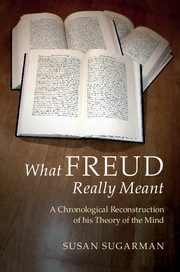Book contents
- Frontmatter
- Dedication
- Contents
- Acknowledgments
- Introduction
- 1 Freud on psychoanalysis: Five Lectures on Psychoanalysis (1909a)
- 2 The pleasure and reality principles: “Formulations regarding two principles in mental functioning” (1911); “The psychology of the dream-processes” from The Interpretation of Dreams” (1900)
- 3 Ambivalence and the origin of the civilized mind: “Taboo and emotional ambivalence” from Totem and Taboo (1913b)
- 4 Narcissism as a stage in development: “On narcissism: an introduction” (1914)
- 5 The impetus to the mind: “Instincts and their vicissitudes” (1915a)
- 6 The possibility of repression: “Repression” (1915b); “Negation” (1925a)
- 7 The unconscious and the structure of the mind: “The unconscious” (1915c)
- 8 Beyond the pleasure principle: Beyond the Pleasure Principle (1920)
- 9 A new architecture of the mind: The Ego and the Id (1923)
- 10 Pleasure revised: “An economic problem in masochism” (1924)
- 11 Civilization, morality, and the pursuit of pleasure: Civilization and its Discontents (1930)
- Epilogue: What Freud really meant
- References
- Index
9 - A new architecture of the mind: The Ego and the Id (1923)
Published online by Cambridge University Press: 05 April 2016
- Frontmatter
- Dedication
- Contents
- Acknowledgments
- Introduction
- 1 Freud on psychoanalysis: Five Lectures on Psychoanalysis (1909a)
- 2 The pleasure and reality principles: “Formulations regarding two principles in mental functioning” (1911); “The psychology of the dream-processes” from The Interpretation of Dreams” (1900)
- 3 Ambivalence and the origin of the civilized mind: “Taboo and emotional ambivalence” from Totem and Taboo (1913b)
- 4 Narcissism as a stage in development: “On narcissism: an introduction” (1914)
- 5 The impetus to the mind: “Instincts and their vicissitudes” (1915a)
- 6 The possibility of repression: “Repression” (1915b); “Negation” (1925a)
- 7 The unconscious and the structure of the mind: “The unconscious” (1915c)
- 8 Beyond the pleasure principle: Beyond the Pleasure Principle (1920)
- 9 A new architecture of the mind: The Ego and the Id (1923)
- 10 Pleasure revised: “An economic problem in masochism” (1924)
- 11 Civilization, morality, and the pursuit of pleasure: Civilization and its Discontents (1930)
- Epilogue: What Freud really meant
- References
- Index
Summary
We have formed the idea that in each individual there is a coherent organization of mental processes; and we call this his ego. It is to this ego that consciousness is attached …. We have come upon something in the ego … which is also unconscious.
– S. Freud, The Ego and the Id, p. 17.In The Ego and the Id Freud systematizes the conceptualization of the mind's architecture that has evolved steadily through his works and for which he is best known, the tripartite schema of id, ego, and superego. The id comprises our unmediated impulses, the ego our judging and thinking self, and the superego our conscience. Freud develops the justification for his shift to this conceptualization, details its constituents, and explores further, now in distinctly psychological terms, the dualism of the life and death instincts introduced in Beyond the Pleasure Principle (see Chapter 8 here). The Ego and the Id hews more closely to clinical observation and leaves biology aside. It drives all the works that follow it.
The most course-changing contribution of The Ego and the Id beyond the new structural vocabulary is Freud's delineation of the superego. Humans, according to Freud's conception, develop a self-monitor concerned specifically with propriety. The process evolves in part in response to the differentiation from the parents and its attendant ambivalence. We want our autonomy and must grow away from the parents; at the same time, we wish to continue their embrace and protection. Installing an internal version of them – forming a superego – accomplishes both of these aims: we gain our independence from them, and we keep them with us. Were the superego born solely of this dynamic, it would have an enveloping and softening character. Instead we have a harsh critic and judge. Freud spends much of the latter part of the book attempting to account for that discrepancy.
A NEW STRUCTURAL TAXONOMY
The Ego and the Id begins with a demonstration of the inadequacy of the structural division of the mind into conscious and unconscious portions (see Chapter 7) in providing full account of the mind's dynamics: both the impulses we repress and the forces that lead us to repress them and “resist” their re-emergence are unconscious.
- Type
- Chapter
- Information
- What Freud Really MeantA Chronological Reconstruction of his Theory of the Mind, pp. 105 - 121Publisher: Cambridge University PressPrint publication year: 2016



